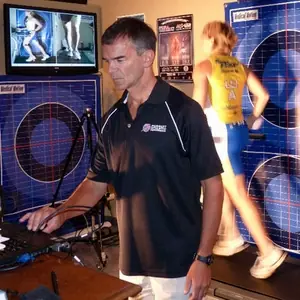
Many people think gait analysis is all about—and only about—someone watching you walk or run and evaluating your feet and your shoes. How many of you have done the following? A clerk in your local running store watches you jog, and suggests a pair of shoes that are more stable, or more neutral, or more cushioned, or are the type that "forces" you to land mid-foot. Voila! Your biomechanical problems are solved. This is what most people know and have come to accept as gait analysis.
Let's examine the most common misconceptions about gait analysis, and create a real picture of what it is, what it isn't, and how it can be helpful to you as an athlete. True gait analysis is not a generic exercise, but is a scientifically-based and technically-precise process. It is highly individualized, and reveals a lot about how you will hold up to training and, ultimately, perform.
What Is a Gait Analysis?
When we conduct a gait analysis, your feet are only one small piece of your biomechanical puzzle. What happens to your feet is merely part of a holistic, whole body, integrated movement pattern. Running, like most other whole-body activities (such as swimming or many field sports), is essentially a unique way of moving.
More: Midfoot Strike Vs. Balls of the Feet
Gait analysis uncovers precisely how your body is moving. Every activity, even standing still, represents a unique movement pattern. That pattern is bred from your habits and lifestyle, as well as your body's mobility, stability, flexibility and strength. Every action you take—running stride, pedal stroke, swim stroke, etc.—represents that unique movement pattern. If your movements include compensations (and they likely do), gait analysis can pinpoint the areas in the body where these losses of efficiency originate.
More: Overpronation: Why It Happens and What to Do About It
Athletes get into trouble when major compensation, which often leads to true dysfunction, continues for extended periods of time.
How Compensations Affect Your Gait
Compensations in the body lead to imbalance around the joints. The larger prime movers (hamstrings, glutes, quads, etc.) become less active, and end up contributing less than their fair share of the work in moving us around. The smaller/tiny stabilizing muscles are forced to step in (compensate) and do the work of the larger, more powerful prime movers. The stabilizers are taxed day in and day out, mile after mile. Over time they end up, in a word, fried. Shredded. The wear and tear on the stabilizers greatly compromises recovery and your ability to train consistently. In short, this scenario is an injury waiting to happen. We see it over and over again.
Discovering the inefficiencies and compensations unique to you is the power of what true gait analysis can reveal. Once uncovered, these inefficient and costly "energy leaks" that rob you of power and free speed can be addressed. This cannot be overstated: Improper, unbalanced movement limits your ultimate potential and puts you at an exponentially-increased risk of injury.
More: Tips for Energy-Efficient Running
In short, gait analysis is about you, and your personal and unique way of moving. Unless the underlying causes of your dysfunctional movement patterns are addressed, your patterns won't change, and, thus, the risk of injury won't improve. Gait analysis is about looking at your entire body as a holistic organism—a single amazing unit. It goes far beyond an untrained eye watching you jog in a pair of sneakers.
More: 4 Fast Tweaks to Run Like the Elites
 Sign up for your next race.
Sign up for your next race.About the Author

Get ACTIVE on the Go


Couch to 5K®
The best way to get new runners off the couch and across the finish line of their first 5K.
Available for iOS | Android








Discuss This Article